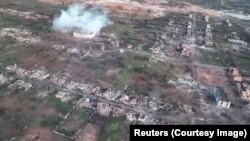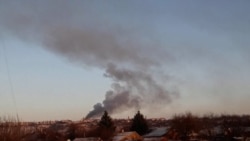As Moscow's forces advance, Russia and Ukraine continue to dispute control of the salt-mining town of Soledar amid scenes of devastation and fierce fighting on the front line in eastern Ukraine.
Russia has made multiple claims of control in the past week that have been contested by Ukrainian officials, who maintain their forces have not left the town and continue to fight. Russia's Defense Ministry claimed on January 13 to have seized Soledar, but the statement was quickly disputed by Kyiv, with Ukrainian President Volodymyr Zelenskiy saying the fight for the town and others "in the east of our country continues."
RFE/RL could not verify the situation independently, but multiple reports by Russian war correspondents and bloggers who have shown their geolocations via the messaging platform Telegram suggest Russian forces have taken nearly all of Soledar. Ukrainian forces, however, appear to still hold ground on the northwest edge of the town, with Ukraine's 46th Air Assault Brigade saying fighters were surrounded but fighting back.
Speaking to Current Time, a Russian-language network run by RFE/RL in cooperation with VOA, Volodymyr Nazarenko, the deputy commander of a battalion in the Ukrainian National Guard, said heavy fighting in Soledar has already destroyed much of the town and the surrounding area but Ukrainian forces were determined to "knock out" the Russians from their positions.
"Soledar is now just several square kilometers of scorched earth and a few fields," Nazarenko said from Donetsk during an interview. "It seems there is barely a single [intact] building left."
Military analysts question the strategic value of Soledar or nearby Bakhmut, which has also been the site of some of the most intense fighting in the war in recent weeks. Still, a Russian advance would be welcome news for the Kremlin following a string of embarrassing setbacks and Russian forces being unable to capture a single town in Ukraine since July 2022.
Amid the push on the ground, the battles for both locales have killed thousands of soldiers on each side. Nazarenko suggests any Russian gains on the eastern front would be a Pyrrhic victory due to how difficult it would be for Moscow to hold on to any advances following such heavy losses.
"Our task is to make the enemy exhausted," Nazarenko said. "Bakhmut and the Bakhmut direction were a kind of trap for the enemy…. Sooner or later, they will run out of steam."
A 'Bloodbath'
Both Soledar and Bakhmut have been the focus of a grinding artillery battle since late summer, and Ukrainian officials have described the waves of Russian soldiers launched into the carnage to take the locations.
While Ukrainian officials have spoken about the battles for Soledar and Bakhmut being part of a strategy to occupy and inflict disproportionate losses on Russian forces, the fighting has also absorbed thousands of Ukrainian soldiers who could be deployed elsewhere.
Barely any walls in Soledar remain standing, Zelenskiy said during an address to the nation on January 13 in which he described grim scenes of missile strikes and the streets littered with corpses.
Andriy Yermak, Zelenskiy's chief of staff, compared the fighting to that in Verdun, the longest battle of World War I. Donetsk Governor Pavlo Kyrylenko called the area a "bloodbath."
Both Russian and Ukrainian officials say they are evacuating civilians. Kyrylenko said that only around 600 residents remain in Soledar compared to a pre-war population of more than 10,000. Multiple Russian news agencies have reported their forces have already evacuated 170 people from neighboring towns and villages to positions held further east in occupied territory.
While analysts continue to raise questions over the strategic significance of the fierce fighting for Soledar and Bakhmut, Russia has invested heavily in trying to take the eastern towns, which hold symbolic value for the Kremlin amid its lackluster battlefield results.
According to a January 13 analysis by the Institute for the Study of War, a U.S.-based think tank, it seemed likely Russian forces would be able to control Soledar but the heavy casualties sustained would make it "unlikely to presage an imminent Russian encirclement of Bakhmut."
Tensions Among Russia's Factions
The battle in Soledar has also exposed divisions between its regular forces and the Wagner mercenary group.
Wagner has been leading a monthslong push to try to seize Soledar and the neighboring city of Bakhmut, which would be a symbolic win for the mercenary outfit and its leader, Yevgeny Prigozhin.
Many analysts have suggested Prigozhin is hoping to shore up his political standing in Moscow and secure a public relations win in the process by showing that his forces are able to seize territory where Russian troops have stalled.
This sparked a turf war between the factions that played out this week, as both sides contradicted each other and sought to take credit for the Russian advance.
WATCH: The strategic town of Soledar sits on a vast network of salt-mine tunnels that cover an estimated 200 kilometers.
When Russia's Defense Ministry said its troops had taken control of Soledar on January 13, the statement made no mention of Wagner being part of the operation.
Shortly afterward, Andrei Troshev, a senior Wagner commander, accused the ministry of stealing "other people's achievements" in a Telegram post.
Three days earlier, Prigozhin had claimed Soledar had fallen to Wagner fighters and made no mention of regular Russian forces before taking to his Telegram channel on January 13 to chastise Russia's military command.
"It looks like there are three armies fighting [in eastern Ukraine]: the Ukrainian Army and then two Russian ones that interact poorly and even compete with one another," Olga Romanova, the head of the Russia Behind Bars foundation, told Current Time. "In general, they don't like each other."
U.S. officials estimate 4,000 of Wagner's 50,000 mercenaries have been killed on the front lines along Soledar and Bakhmut, with 10,000 injured. While the battles have highlighted the cracks among Moscow's forces, the reliance on Wagner in Soledar has freed up other Russian units to operate elsewhere.
Russia's Defense Ministry would go on to credit Wagner as being part of the advance following the outbursts from Prigozhin, but Romanova says the factionalism on display in Soledar shows no signs of waning.
Thousands of inmates are said to have joined Wagner in recent months, with videos surfacing of Prigozhin personally recruiting from prisons across Russia. Prisoners have formed the bulk of the new recruits for the mercenary group, and its ranks have been thinned amid heavy casualties of late.
Wagner has also taken to publicly executing deserters and disobedient troops from its ranks, according to statements from former inmates captured by Ukrainian troops and seen in released videos by the mercenary group.
Romanova says the battlefield losses and alleged executions have hurt Wagner's ability to recruit, even inside prisons where inmates were offered a path to commuting lengthy sentences by fighting in Ukraine.
"Recruitment has very much slowed down at the end of December, when more footage of extrajudicial executions began to circulate," she said. "These executions appear to have stopped people fleeing or surrendering in Ukraine, but they've also brought recruitment to a near stop, too."

















